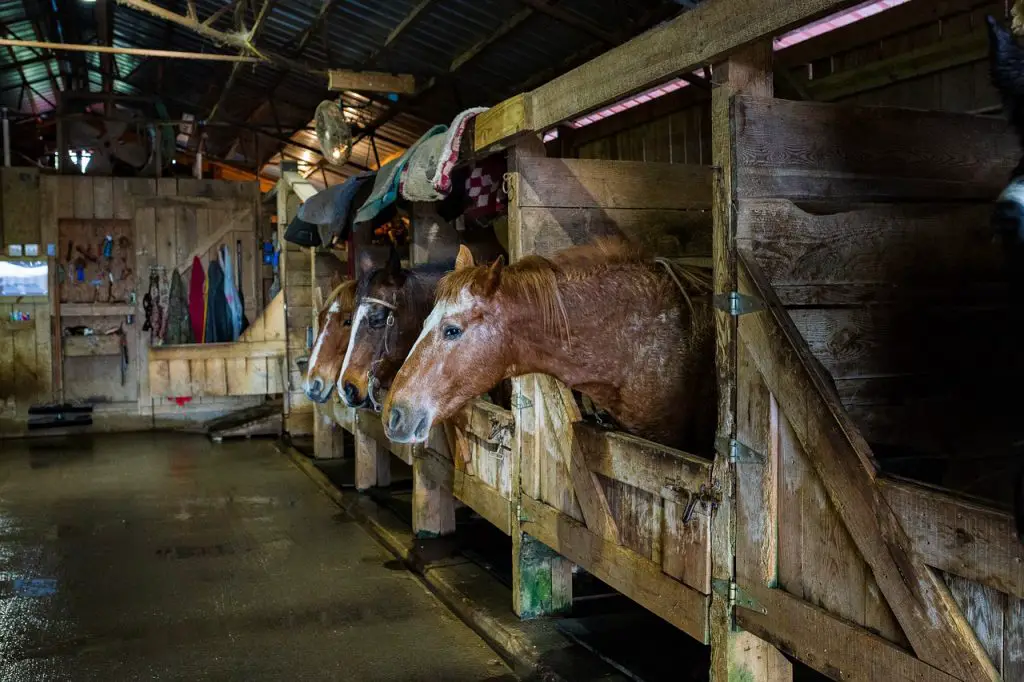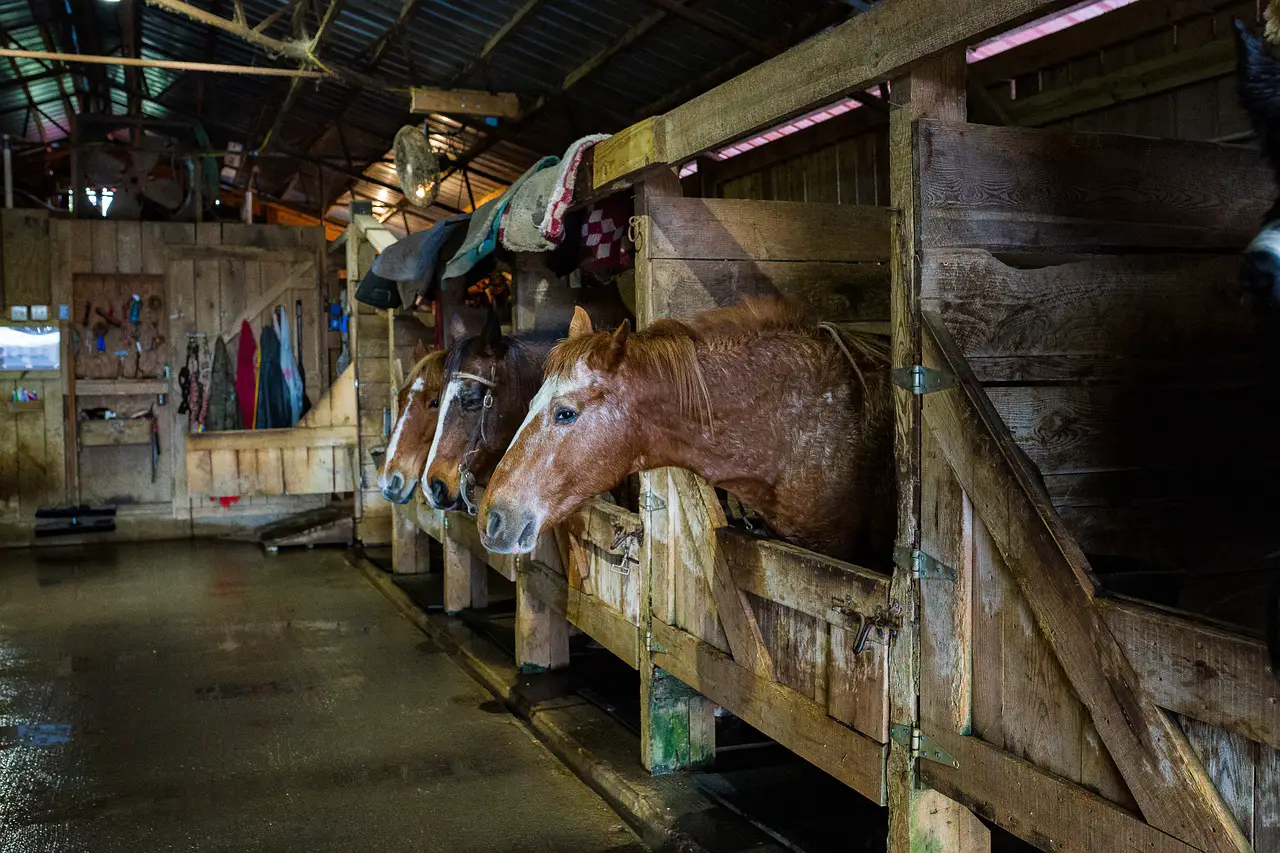Last Updated on February 28, 2022 by Allison Price
A properly designed barn will ensure the safety and health of all horses, from foal to senior. It will also allow each horse to perform to its best. A good barn will result in fewer vet visits, lower maintenance costs and lower repair bills.
You will save money by creating a barn that is comfortable for both you and your horse.
A barn of exceptional quality
Beautiful architecture and landscaping make this barn stand out from the rest.
Experts in barn design have published books and made available internet resources that can be used to assist horse owners with their property design, whether they are building a new facility or restoring an existing one. This guide will help you understand the key considerations in making your dreams a reality.
What does a well-designed horse barn accomplish?
A well-thought-out barn can accomplish these things:
- You can make your life easier by making sure you have functional spaces. This will allow you to save time and help you communicate with your horse.
- Provide maximum interior light and ventilation.
- Protect horses, people, horses, tack, feed, or other necessities from the elements as well as damage or misuse.
- Protect against rodents, pests, fumes and odors.
- Use of carefully selected materials will ensure safety for horses, handlers, and other animals. Allow horses, handlers, and others to safely pass through the area with appropriate doors, gates, or alleyways.
- Waste disposal made easy and efficient
Note on animal welfare
Barn housing is essential for the well-being of your horse. Barn housing is not natural for horses. Barns can isolate horses and limit contact, which can lead to a reduction in social interaction. Barn housing can also limit exercise and lead to boredom. It can also increase the risk of abnormal behaviors.
You must also plan for pasture turnout and important social time for horses to interact with one another. This will ensure the horse’s health and well-being.
Basic barn functionality
These are important considerations to ensure that your barn functions in the best interest of both you and your horse:
Layout and size
The size and layout of your barn depends on the number of horses and how often they will be used. Your barn may be different if you live in colder climates. Your barn needs to be able to accommodate a competitive rider. You should consider:
- Size of the stall
- Passageways and open areas for work
- Location and size of doors and windows
- Layout of the tack room and blanket/equipment storage
- Grooming and wash rack
- Access to and storage of feed
- Access to water distribution
Interior lighting and ventilation
Modern horse barn breeze-way
Modern horse barns feature wide aisles, excellent lighting, ventilation, and floor mats.
Proper lighting and ventilation can make or break a barn’s health. Poor lighting and ventilation can have a negative impact on the mental and physical health of horses and handlers.
Dust and mold can be found in hay, grains, and bedding. Ammonia fumes and particles of fecal material, fungal material, viruses, bacteria, and methane combine with moisture in air to cause allergies and respiratory distress.

Proper ventilation should take into account the horse’s need for air. Good ventilation should allow your horse to benefit from wind, air currents and thermal buoyancy.
Natural ventilation is achieved by openings along the walls and roof ridges. It also considers the topography of the barn relative to its surroundings.
A well-designed barn will provide fresh air for horses, and not just follow residential housing practices.
If the barn is closed tightly, you should allow maximum circulation to take place. According to veterinarians, horses feel most comfortable when temperatures are between 45 and 75 degrees. Fresh air can also be circulated in order to control moisture, ammonia, and pathogen buildup throughout the year, according to veterinarians.
Properly installed fans, duct systems, and an open-door policy whenever feasible will maximize ventilation efficiency, especially in stall areas.
The county extension office or universities that have animal programs can provide information and plans regarding adequate ventilation in barns and stables in your region.
Horse barn with natural lighting and high ceilings
You can design pre-fabricated and steel horse barns to create bright, airy living spaces. These barns are less likely to catch on fire than their wooden counterparts.
Good lighting should also be considered in barn and stable designs. Skylights and the sensible placement of windows should let maximum light in the barn during daylight hours.
It is easier to live and work in sunlight than under artificial light. However, it is also a powerful killer for a variety of airborne viruses, bacteria and parasite eggs.
Editor’s Note
In the past few years, there has been a shift away from glass or Plexiglas windows which can shatter or break and create a danger. Skylights, light strips on the roof and other lighting systems for barns are becoming more popular.
To allow the beneficial UV rays from the sun to reach stable areas and barns, skylights must be made of plastic or UV light transparent safety glass. Windows should be made from safe materials. They should be able to open and close securely, and take advantage of as much natural sunlight as possible.
Protection of the horse barn against the elements, damage, and misuse
Your barn and stable design should provide protection for you and your animals against the elements of wind and rain, snow, heat, and cold. It should also prevent injury by horses or humans.
The barn’s structure should be strong enough to withstand the elements. However, the inside trappings and supplies that are located in the barn and stables must not be damaged or misused.
Horses are often wily and can chew through doors and walls, electrical wiring, plumbing, insulation and other components of a barn or stable. If these options are not considered, they can kick or kick at you. It is important to think like a horse when designing and building your barn or stable. This is especially true if your horse engages in stereotypies like stall walking, cribbing, and kicking.
Barn door security
Horses are masters at opening standard door and gate latches. You should look for latches that are specifically designed to stop your horse’s attempts.
Your horse will not damage important barn components by not securely covering plumbing and electrical wiring.
Horse-proof latches are essential if your horse doesn’t want to enter the feed storage area.
Feed and tack should be properly secured to prevent invasions by rodents and insects.
All medications, dewormers and insecticides that could be potentially fatal for your horse’s health, should be stored in accordance with the manufacturer’s instructions. Only those who are trained in their use should have them.
To prevent moisture and drainage problems, wash racks and horse waterers must be installed correctly. You can do some research to determine which horse waterers are best for you, and where they should go to encourage your horse’s thirst.
You should make provisions for drying floors and other areas, as well as for quickly and efficiently removing water from any area. This will prevent any damage to horses, handlers, or the structure.
Protection against rodents, pests, fumes and odors.
A barn or stable that is well-designed will be rodent- and pest-proof. It will also be constructed to avoid the accumulation of dust, dirt, and fumes.
Flies, parasites and gnats can be found everywhere horses are kept. Rodents can also be attracted to grain and feed, and can pose a problem if they aren’t prevented.
Effective measures against pests and insects include using traps or hang fly strips, biological controls like predatory wasps that feed upon fly larvae, or dressing your horse with a fly sheet, sheet, or leg wrap.
The barn cat
Barns are very familiar with the practice of having a barn cat or several barn cats that provide rodent control.
The legend of the barn cat is well-known to all. A few cats can be helpful in reducing rodent populations. It will help you save time and money by keeping feed and grains out of reach of rodents, and other animals like raccoons.
Proper ventilation, regular bedding changes, mucking of stables and the use of effective cleaning products in all areas of the barn, stables and barn can eliminate noxious odors and fumes such as ammonia from urine and manure.
Hay should be kept in a separate area and not in the barn loft to ensure safety from fire. This will also reduce dust, mold, and other pests that are common in hay.
Regular cleaning and sweeping of dirt and debris, combined with the placement of enough trash bins can reduce the work required and increase the cleanliness of barn areas.
Safety for horse and handlers
The safety of horses and their handlers is an important concern when designing and building any barn or stable. Safe passage is essential for all occasions. This includes daily use, as well as in emergency situations such fires and floods.
Good design and construction will enable workers to water and feed horses without having to walk behind them. It will also allow storage of supplies and equipment in areas that won’t cause bottlenecks or create obstacles.
To avoid potentially fatal mishaps and injuries, it is essential to use durable, fireproof materials throughout all stages of construction. Horse-proof materials should be used to build doors and walls.
In your decision-making process, you should consider ease of maintenance, durability and aesthetic appearance. You should also consider flexibility in construction, which allows for future changes and alternative uses.
A horse and owner in a wash rack
Modern horse facilities must be safe for horse and horse owners.
It is especially important because the wash rack can be one of the most dangerous areas in the barn. Avoid slippery surfaces that are wet and make provisions to avoid potential electrical or water hazards.
Safety of horse and handler is dependent on the position of water hoses, grooming equipment, and cleaning equipment.
Efficient and simple waste disposal
No matter how many horses you own, ammonia-soaked and accumulated manure can quickly become a problem. It is important to consider waste disposal as a top priority when designing your barn or stable area.
It is both important for efficiency and health to construct stalls and feeding areas in the barn.
When planning your barn or stable area, consider the layout of the floors, doors, shoveling, sweeping, disposal and other details.
Properly disposing of waste can have very positive effects on your horse’s health and well-being.
Take a look at this
It can be difficult to create a healthy barn. It is best to approach it one step at a given time, taking into consideration your requirements for durability, ease-of-maintenance, cost, aesthetic appearance, and your pride and satisfaction with your achievement.



